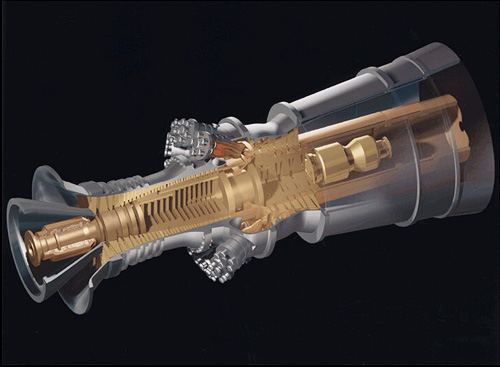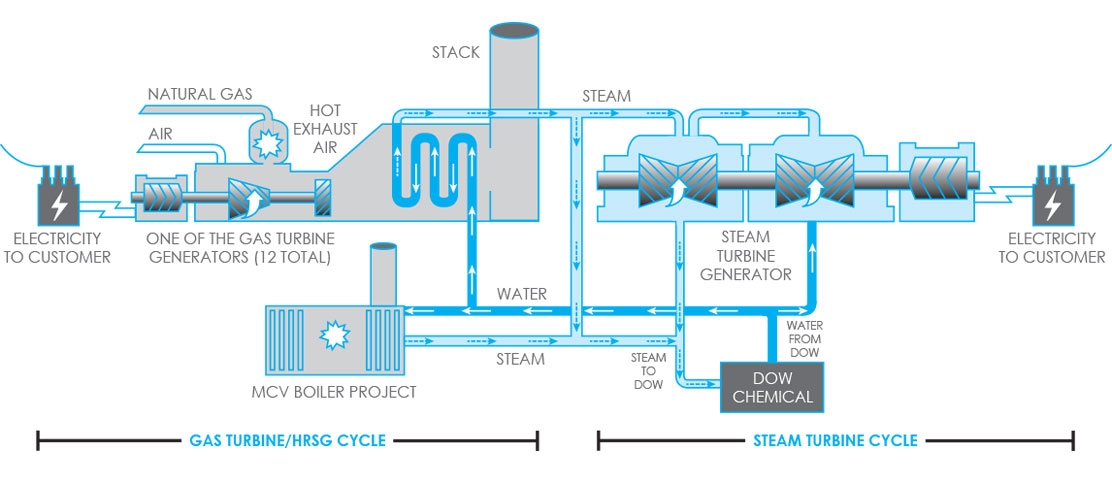Excellent news! No math today. Bad news! There are some confusing terms here. Every thermal power plant drives a turbine to produce power. There is a special type of turbine called a gas turbine that directly burns natural gas inside of it to produce power. There are a few places where I use gas turbine and turbine in the same sentence. Sorry about that.
Natural gas fired power plants come in two primary flavors: standard thermal plants, and fancy jet turbines. The former has the same internals as a coal power plant and can provide baseload power, the latter is for peak power. Both produce less pollution than coal, simply because natural gas is cleaner than coal and produces more energy per unit CO2 emitted. Natural gas plants contribute to GHG emissions and PM2.5 (PM 2.5 can form from emissions of NOx, which occurs from any combustion). With hydrofracking causing a glut in natural gas in the US, producing power via gas is cost-competitive with coal in the US, and recently has been replacing coal to produce electricity. This has caused the US to decrease its annual CO2 emissions by nearly 10%.

Conceptual drawing of a natural gas turbine
Let’s get down into the meat of how these plants work. We have discussed how standard thermal plants work in a prior post. The jet turbine power plant is pretty simple. It is very similar to the turbines found on airplanes. The fuel is injected and burnt. It expands and drives a turbine to generate electricity. These systems get incredibly hot. They have thermal efficiencies approaching 30%. Unlike thermal plants, these gas turbines can fully ramp up power in about 20 minutes. These turbines also need to shut down frequently for repairs. Continuous operation for days at a time is not possible, or they will become very damaged. For these reasons, these turbines are typically used only for peak power production. One final difference is that a gas turbine has more like a 20 year life time, whereas a thermal power plant has a 50 year lifetime.

A natural gas turbine via DOE
Gas turbines can be combined with standard thermal plants often use what is called a combined cycle format. Before getting into that, let’s briefly revisit how a normal thermal plant has higher efficiencies. In a normal thermal power plant, the steam coming out of the first turbine has lost some heat and pressure. It is then more or less directed to a subsequent turbines that are designed to be efficient at lower temperatures, and even with wet steam. This series of turbines extracts much more heat, and thus much more efficiency, than a single-cycle turbine.
This combined cycle power plant has two sections: the thermal section and the gas turbine section. Typically the thermal section stays on. When peak electricity production is needed, the gas can go into the gas turbine instead of the thermal section. Our gas turbines discussed above produce temperatures in excess of 900 C. This waste heat can then be shunted to boil water in a more traditional thermal plant. Combining these processes together can result in a 60% thermally efficient plant. This is very efficient. If you recall from our previous article, thermal plants take a long time to ramp up power production. These combined cycle plants require the thermal section to almost always be on. The thermal section of the plant will provide baseload power, and the gas turbine part will spin up to provide peak power. These combined cycle plants are incredible versatile. They make money every day by operating in baseload configuration, and then make extra money as soon as demand requires more power.
This brings up a quick question. The thermal section of the plant is not as efficient as using both the gas turbine and the thermal section together. In other words, burning the natural gas in the gas turbine first extracts more energy from it. Why do these gas turbines not always run, then? Well, as we mentioned, the gas turbines are more fragile. They can’t always run, and they need frequent repairs. The economics of it works out so that even though they extract more energy from the gas, it is only worthwhile when electricity prices are high.
What are the downsides of these NG plants? They produce less pollution than coal plants by a good margin. They require less mitigation of pollutants, so they are much easier to build than coal plants, and are built more rapidly at a lower expense. They produce less GHG than coal plants, both because the combined cycle system is more efficient and because NG is a more CO2 efficient fuel than coal. They produce more pollutants than nuclear power plants or wind turbines or solar power, however. And outside of the US, the fuel is much more expensive than coal.
Let’s discuss that last point for a second. The low NG price in the US makes this very affordable. Other countries that care more about clean air than the US are not as concerned about the higher price of natural gas vs. coal electricity. They care more mitigating adverse health effects caused by coal power plant emissions. Japan is a great example. The largest importer of natural gas in the world, Japan is set to import a lot more of it. After the Fukushima Daiichi nuclear plant meltdown (future post on this and Chernobyl!), Japan is set to phase out nuclear power. They don’t want to build coal power plants, because they are dirty. They intend to import gas (they are even considering building an undersea pipeline from Russia to accomplish this!) and produce NG electricity to replace their retiring nuclear plants.
The technical section
The major emissions of these power plants are CO2, methane, and NOx. On a 100 year timescale, each molecule of methane and NOx is 21 and 310 (respectively) times more powerful than CO2. This scaling of potency is called the Greenhouse Warming Potential (GWP) of a compound. Methane is leaked from incomplete combustion and also from line leaks and delivery leaks, NOx is a byproduct of burning things in a nitrogen based atmosphere. Another way to put it: since our atmosphere is 78% nitrogen, burning anything, even a campfire, will produce NOx. In the graph below, excerpted from an NREL document , we see that while CO2 is the primary emission, multiplying these emissions by the GWP shows that methane is a significant % of total warming potential.
Relative to the other natural gas emissions, NOx is not important to greenhouse warming. Why would they want to control it? Because it is a precursor to PM2.5. The stuff that causes minor health issues, like heart attacks and death. NOx is mitigated by spraying ammonia (NH3) into the flu gas (flu gas is a fancy way of saying the stuff that comes out of the smokestack). The NH3 mixes with NOx to produce H2O and nitrogen. Some NOx is still is emitted after this scrubbing, and still leads to PM2.5, causing local pollution. But in much less quantity than a coal fired plant.
In review, natural gas power plants produce less pollution than coal fired power plants. There are some pretty neat technologies in these natural gas power systems. In the US, the electricity is nearly cost-competitive with coal. Other countries choose to produce power via natural gas because it is cleaner than coal, despite that it is 5x as expensive in those countries.
That’s all! Thanks for reading!



Pingback: Nuclear Power, Saving Lives and the EnvironmentJason Munster's Energy and Environment Blog
Pingback: Solar Roadways - Not a Energy/Climate Solution, but Potentially GreatJason Munster's Energy and Environment Blog
Thanks Jason for a very illuminating article. Interesting how the conversation around NG is always limited to the burning of it, and not to the extraction. Forget about Deepwater Horizon, the greatest man-made environmental disaster of the 21st century. Forget about benzene winding up in our drinking water, or man-made earthquakes in Oklahoma. Forget about the methane leaking out of the wells, and the occasional nasty pipeline rupture. The oil and gas industry has done a great job of controlling the debate; banish the thought that coal is much safer to extract and transport.
I didn't realize that there are two different types of natural gas power plants. It is cool that there is a certain kind that uses jet turbines. That is a good thing to be aware of when you need to choose a natural gas plant.
Great blog on Combined cycle GT ! Just enough, full stomach !